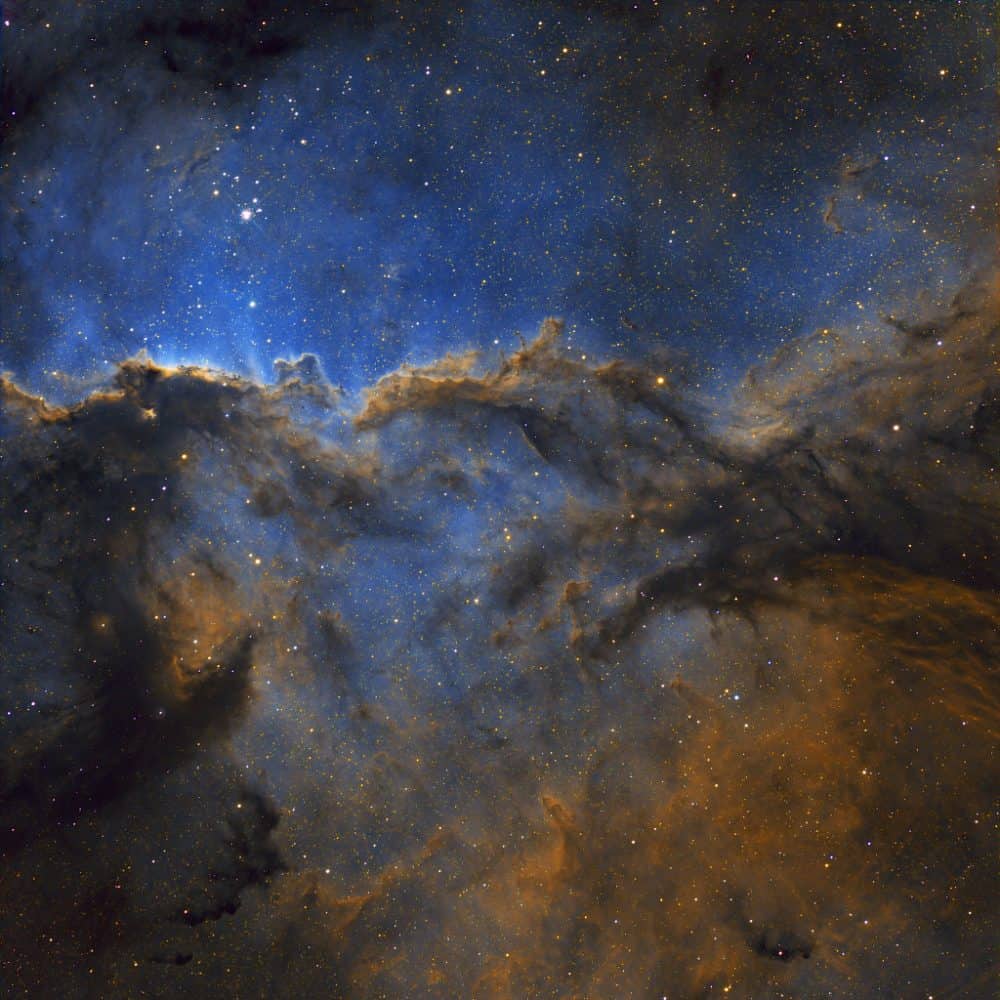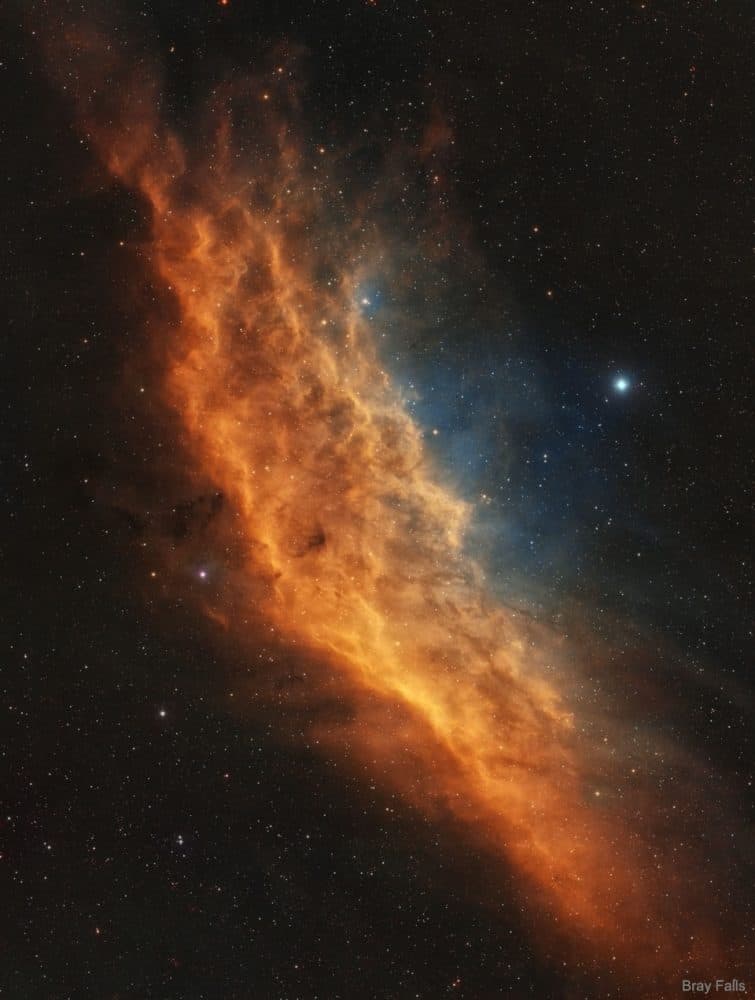Blog
In a dense swampland in Georgia, just north of the Florida border, you find the headwaters of the Suwannee River. The Suwannee is known as a “blackwater river” because of its dark-brown waters laden with organic material. This river system has been called one of the most pristine in the United States, but some environmental pressures are putting that distinction in jeopardy.
Unlike other blackwater rivers, the Suwannee maintains its inky color along its entire 400-kilometer (250-mile) journey to the sea. When the river finally meets the Gulf of Mexico along Florida’s Big Bend—that portion of coast where the state’s panhandle curves to meet its peninsula—its dark waters act like a tracer, revealing whereby the river water mixes with the sea. That mixing was on display on February 20, 2015, when the Operational Land Imager on Landsat 8 captured this view.
The image above was entered into NC State’s Envisioning Science image contest by Alice Alonso, a former research scientist in the university’s Biosystems Analytics Lab and now a researcher at the Université catholique de Louvain. As she described, the image “captures a large river discharge event, which resulted in a mesmerizing dark river plume contrasting with the deep blue color of the Gulf of Mexico.” It is, in effect, a testament to the freshwater contribution of the Suwannee River to the sea and an echo of the unique, swampy ecosystem.
more...Donald Byron (born November 8, 1958) is an American composer and multi-instrumentalist. He primarily plays clarinet, but has also used bass clarinet and saxophones.
Though rooted in jazz, Byron’s music is stylistically eclectic. He has worked in many different musical genres, ranging from klezmer music and German lieder, to Raymond Scott‘s “cartoon-jazz,” hard rock/metal, and rap. Most of Byron’s albums have been conceptual, devoted to works of a particular musician and/or style of music.
Byron was born in The Bronx, in New York City. Both parents were musicians: his mother was a pianist and his father played bass in calypso bands. As well as listening to jazz recordings by Dizzy Gillespie, Miles Davis and others, he was exposed to other styles through trips to the ballet and symphony concerts.
more...Kenny Cox (November 8, 1940 – December 19, 2008) was a jazz pianist performing in the post bop, hard bop and bebop mediums. Cox was pianist for singer Etta Jones during the 1960s and was also a member of a quintet led by trombonist George Bohannon. By the end of the late 1960s he had formed his own Kenny Cox and the Contemporary Jazz Quintet, which recorded two albums for Blue Note Records before the end of the decade. Cox has appeared as a contributor on various albums, and has also performed live with such musicians as Rahsaan Roland Kirk, Eddie Harris, Jackie McLean, Roy Haynes, Ben Webster, Wes Montgomery, Kenny Dorham, Philly Joe Jones, Kenny Burrell, Donald Byrd, Roy Brooks, Charles McPherson, and Curtis Fuller. During the 1980s he formed the Detroit-based Guerilla Jam Band, a group which performed with Regina Carter, James Carter, Tani Tabbal, and Craig Taborn. Cox was responsible for the short-lived Strata Records.
more...
Warren Battiste was born in New Orleans in 1925 and was taught to play the guitar by his father who was a banjo player at Preservation Hall. Warren has performed at numerous jazz clubs on Bourbon Street, Preservation Hall, Snug Harbor, the Matador and many others. Warren also appeared in the film “Shy People” with Jill Clayburgh and Barbara Hershey. He has taught music at Wequachie High School, Essex County College and the Newark Art Center in Newark, New Jersey. Warren has performed with George Benson, The Platters, The Inkspots and Illinois Jacquet to name a few. In 2000 he received the Lifetime Achievement Award in Jazz from the New Orleans Jazz and Heritage Festival.
In 2001 he released his debut CD “Street Jazz” to rave reviews.
In 2004 he was backed by Nocturnal Records for a second CD entitled “Just Friends”.
In 2007 Progressive Records, a division of George Buck’s recording company in New Orleans, released a third CD entitled “Quiet Storm”.
WARREN BATTISTE BIO
BIRTHPLACE: New Orleans, Louisiana on November 8, 1925
EDUCATION: Father was a banjo player at Preservation Hall and the initial Instructor to young Warren. Later Warren completed 4 years of instructions at Gruenwald Music School in New Orleans.
INSTRUMENTS: Primary: Guitar
Others: Bass, Banjo, and Piano
EXPERIENCE:
Featured on Louisiana Jukebox May 2002 and September 20, 2002. Featured artist in UNO’s Jazz Series April 2002. Numerous jazz clubs around Bourbon Street in the French Quarter, Preservation Hall, Harrah’s Casino, Club 201, Snug Harbor, The Matador, Café Sbisa, and many others.
Cameoed in the Motion Picture, SHY PEOPLE, starring Jill Clayburgh and Barbara Hershey.
Taught Music at Wequachic High School, Essex County College, and Newark Art Center in Newark, New Jersey.
PERFORMED WITH:
George Benson Jimmy McGriff
The Platters Frank Foster
The Inkspots Barry Harris
Illinois Jacquet Woody Shaw …and many others
Arnold Dwight “Gatemouth” Moore (November 8, 1913 – May 19, 2004) was an American blues and gospel singer, songwriter, radio disc jockey, community leader and pastor, later known as Reverend Gatemouth Moore. During his career as a recording artist, Moore worked with various jazzmusicians, including Bennie Moten, Tommy Douglas and Walter Barnes, and his songs were recorded by B.B. King and Rufus Thomas. He was noted for his mellow singing voice, much in the style of Billy Eckstine.
Moore was born in Topeka, Kansas, and raised in Memphis, Tennessee, where he sang ballads and spirituals in his youth. He graduated from Booker T. Washington High School in Memphis. Around 1930 he left home, joined F. S. Wolcott‘s Rabbit’s Foot Minstrels, and began performing with Ida Cox, Ma Rainey and Bertha “Chippie” Hill. He toured widely but settled in Clarksdale, Mississippi, around 1934.
more...Dark shapes with bright edges winging their way through dusty NGC 6188 are tens of light-years long. The emission nebula is found near the edge of an otherwise dark large molecular cloud in the southernconstellation Ara, about 4,000 light-years away. Born in that region only a few million years ago, the massive young stars of the embedded Ara OB1 association sculpt the fantastic shapes and power the nebular glow with stellar winds and intense ultraviolet radiation. The recent star formation itself was likely triggered by winds and supernova explosions, from previous generations of massive stars, that swept up and compressed the molecular gas. With image data from the Chilescope Observatory, a false-color Hubble palette was used to create this gorgeous wide-field image and shows emission from sulfur, hydrogen, and oxygen atoms in red, green, and blue hues. The field of view spans about four full Moons, corresponding to about 150 light years at the estimated distance of NGC 6188.
more...Roberta Joan Mitchell, CC (née Anderson; born November 7, 1943), professionally known as Joni Mitchell, is a Canadian singer-songwriter.Drawing from folk, pop, rock, and jazz, Mitchell’s songs often reflect social and environmental ideals as well as her feelings about romance, confusion, disillusionment, and joy. She has received many accolades, including nine Grammy Awards. Rolling Stone called her “one of the greatest songwriters ever”, and AllMusic has stated, “When the dust settles, Joni Mitchell may stand as the most important and influential female recording artist of the late 20th century”.
Mitchell began singing in small nightclubs in her hometown of Saskatoon, Saskatchewan, and throughout western Canada, before busking in the streets and nightclubs of Toronto, Ontario. In 1965, she moved to the United States and began touring. Some of her original songs (“Urge for Going”, “Chelsea Morning“, “Both Sides, Now“, “The Circle Game”) were covered by other folk singers, allowing her to sign with Reprise Records and record her debut album in 1968. Settling in Southern California, Mitchell, with popular songs like “Big Yellow Taxi” and “Woodstock“, helped define an era and a generation. Her 1971 album Blue is often cited as one of the best albums of all time; it was rated the 30th best album ever made in Rolling Stone‘s list of the “500 Greatest Albums of All Time“, the highest entry by a female artist. In 2000, The New York Times chose Blue as one of the 25 albums that represented “turning points and pinnacles in 20th-century popular music”. In 2017, NPR ranked Blue Number 1 on a list of Greatest Albums Made By Women.
Mitchell’s fifth album, For the Roses, was released in 1972. She then switched labels and began exploring more jazz-influenced melodic ideas, by way of lush pop textures, on 1974’s Court and Spark, which featured the radio hits “Help Me” and “Free Man in Paris“ and became her best-selling album.
https://www.youtube.com/watch?v=dUBbDe3DZ1M
more...David Spencer Ware (November 7, 1949 – October 18, 2012) was an American jazz saxophonist, composer, and bandleader.
David S. Ware was born in Plainfield, New Jersey, grew up in Scotch Plains, New Jersey, graduated from Scotch Plains-Fanwood High School, and briefly attended the Berklee College of Music. He moved to NYC in 1973, where he participated in the loft jazz scene, and later worked as a cab driver for 14 years in order to focus on his own group concept. In the early 1980s, he returned to Scotch Plains with his wife Setsuko S. Ware.
Ware’s debut album as a leader was recorded in 1977 – together with pianist Gene Ashton (aka Cooper-Moore) and drummer Marc Edwards – and released by HatHut in 1979. He performed and recorded with the groups of pianist Cecil Taylor and drummer Andrew Cyrille in the mid-late 1970s. He formed his own quartet in 1989. The group was originally composed of Ware, pianist Matthew Shipp, bassist William Parker, and drummer Marc Edwards. While Shipp and Parker were members for the group’s entire existence, the drum chair was later occupied by Whit Dickey, Susie Ibarra, and Guillermo E. Brown.
more...Joe Bushkin (November 7, 1916 – November 3, 2004) was an American jazz pianist.
Born in New York City, Bushkin began his career by playing trumpet and piano with New York City dance bands, including Frank LaMare’s Band at the Roseland Ballroom in Brooklyn. He joined Bunny Berigan‘s band in 1935, played with Eddie Condon from 1936-37, and with Max Kaminsky and Joe Marsala, before rejoining Berigan in 1938. He then left to join Muggsy Spanier‘s Ragtime Band in 1939. From the late 1930s through to the late 1940s he also worked with Eddie Condon on records, radio and television. After service in World War II he worked with Louis Armstrong, Bud Freeman and Benny Goodman.
He married Francice Netcher, elder sister of socialite Mollie Wilmot. The couple had four children – Nina, Maria, Terasa, and Christina. They lived in Santa Barbara, California, on a ranch.
His best-known composition might be “Oh! Look at Me Now“, with John DeVries, written when he worked in Tommy Dorsey‘s band. That song would become Frank Sinatra‘s first hit.
more...Drifting through the Orion Arm of the spiral Milky Way Galaxy, this cosmic cloud by chance echoes the outline of California on the west coast of the United States. Our own Sun also lies within the Milky Way’s Orion Arm, only about 1,500 light-years from the California Nebula. Also known as NGC 1499, the classic emission nebula is around 100 light-years long. On the featured image, the most prominent glow of the California Nebula is the red light characteristic of hydrogen atoms recombining with long lost electrons, stripped away (ionized) by energetic starlight. The star most likely providing the energetic starlight that ionizes much of the nebular gas is the bright, hot, bluish Xi Persei just to the right of the nebula. A regular target for astrophotographers, the California Nebula can be spotted with a wide-field telescope under a dark sky toward the constellation of Perseus, not far from the Pleiades.
more...Aurora “Rory” Block (born November 6, 1949, Princeton, New Jersey, United States) is an American blues guitarist and singer, a notable exponent of the country blues style.
Aurora Block was born in Princeton and grew up in Manhattan. Her father, Allan Block, ran a sandal shop in Greenwich Village in the 1960s, and the influence of the Greenwich Village folk music scene, such as Peter Rowan, Maria Muldaur, and John Sebastian,[1] tempted Block to study classical guitar. At the age of 14, she met guitarist Stefan Grossman, who introduced her to the music of Mississippi Delta blues guitarists. Block began listening to old albums, transcribing them, and learning to play the songs. At age 15, she left home to seek out the remaining blues giants, such as Mississippi John Hurt, Reverend Gary Davis, and Son House, and hone her craft in the traditional manner of blues musicians;[1] then she traveled to Berkeley, California, where she played in clubs and coffeehouses.
more...Arturo Sandoval (born November 6, 1949) is a Cuban American jazz trumpeter, pianist and composer.
Sandoval, while living in his native Cuba, was influenced by jazz musicians Charlie Parker, Clifford Brown, and Dizzy Gillespie, finally meeting Gillespie later in 1977. Gillespie became a mentor and colleague, playing with Sandoval in concerts in Europe and Cuba and later featuring him in the United Nations Orchestra. Sandoval defected while touring with Gillespie in 1990, and he became a naturalized citizen in 1998.
His life was the subject of the film For Love or Country: The Arturo Sandoval Story (2000), starring Andy García. Sandoval has won ten Grammy Awards and been nominated nineteen times; he has also received six Billboard Awards and one Emmy Award. Additionally, Sandoval has performed in a Super Bowl Halftime Show (1995), in an Orange Bowl (2009) at the White House, and at the University of Notre Dame.
On August 8, 2013, former President Barack Obama announced that Sandoval would receive the Presidential Medal of Freedom.
As a twelve-year-old boy in Cuba, Sandoval played trumpet with street musicians. He helped establish the Orquesta Cubana de Musica Moderna, which became the band Irakere in 1973. He toured worldwide with his own group in 1981. The following year he toured with Dizzy Gillespie, who became his friend and mentor. In 1989, Gillespie invited Sandoval to be part of the United Nations Orchestra. During a tour with this group, Sandoval visited the American Embassy in Rome to defect from Cuba. He became an American citizen on December 7, 1998.
https://www.youtube.com/watch?v=ImU2TjosRW4
more...More Posts
- World Music Rishab Prasanna & Sandip Banerjee & Nicolas Delaigue
- Daily Roots Nianatty
- Cosmos NGC 1275
- Anita Baker
- Corky Laing
- Huey Piano Smith
- Clement “Coxsone” Dodd
- Stéphane Grappelli
- World Music Ayisoba
- Daily Roots Marcia Griffiths
- Cosmos LDN 1622
- Etta James
- Antônio Carlos Jobim
- Benny Golson
- Floyd Guitar Smith
- Sleepy John Estes
- SAVE UKRAINE World Music Jamala
- Daily Roots Junior Delgado
- Cosmos Arp 274
- Aaron Neville



